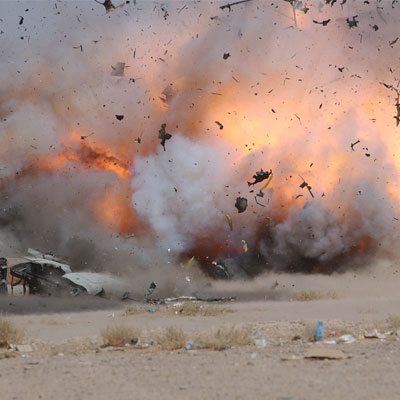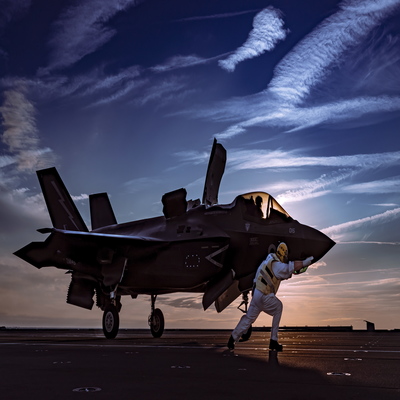Cranfield Ordnance Test and Evaluation Centre (COTEC) performs independent test and evaluation on munitions, weapon systems, pyrotechnic and explosive stores, and conducts disposals and demilitarisation, although its extensive range facilities are suitable for testing other materials and equipment.
COTEC is situated on the edge of Salisbury Plain at Gore Cross near to West Lavington in Wiltshire, England, and is part of Cranfield University, academic provider to the UK Defence Academy at Shrivenham. COTEC is licensed by the MoD and other organisations and is accredited to EN ISO 9001:2008.
Although trials are primarily of energetic materials, ordnance and weapon systems, facilities at COTEC also allow the testing of non-explosive items (for example, rapid decompression). Customers include the UK MoD, the Defence Science and Technology Laboratory (Dstl), foreign defence departments, the Atomic Weapons Establishment (AWE), commercial defence suppliers and manufacturers, as well a large number of smaller specialist companies.
No explosive limits are laid down but daily limits are determined by the use of a meteorological analysis programme, which takes into account prevailing weather, particularly wind and precipitation.
Insensitive munitions testing
The complete suite of IM testing can be carried out at COTEC. In addition, COTEC staff have access to other ranges for testing higher NEC items.
Ammunition proofing

COTEC is one of the few places in the United Kingdom that ammunition containing white phosphorous may be fired. If required prior to firing, the ammunition can be conditioned within the temperature range of -50°C to +71°C.
Ordnance proofing

Explosive trials

Target equipment is varied and has recently included the testing of equipment such as glazing panels, post boxes, litter bins, protective clothing and armoured vehicles.
Bullet and fragment attack

Fragmentation trials

Ballistics experts from Cranfield are also able to offer a complete analysis of the munition.
Testing and evaluation

- Drop testing and Spigot Intrusion: in accordance with Defence Standard 00-35
- Fuel fires: Standard and mini liquid fuel fires tests in accordance with Defence Standard 00-35
- Mine boot testing: derived from NATO document TR-HFM-089 “Test Methodologies for Personal Protective Equipment Against Anti-Personnel Mine Blast”
- Shaped charge jet attack and sympathetic reaction: in accordance with STANAG 4526 and Military Standard 2105B or Defence Standard 00-35
- Slow cook-off: in accordance with Defence Standard 00-35
- UN Series 6c Bonfire.
Specialist trials and demonstrations

Map of facilities
Forward and rear batteries

The rear battery is used for explosive and non-explosive trials that can be contained within its perimeter fence. The forward battery can also conduct short range trials within its security area, but importantly acts as the control and firing area for the majority, more energetic COTEC trials, and for firing into Area 15 and 16 Impact Areas.
Flare test track

High altitude test facility

The cylinder also operates as a reservoir for the rapid decompression chamber in trials to ensure that stores still function safely and reliably having been subjected to rapid decompression.
The facility also has the capability to conduct explosive atmosphere testing.
Workshops

Communication and security

COTEC recently installed a site-wide wireless broadband communication backbone that enables real-time transfer of large-scale data and video around the site and back to the main network areas. The facility allows encrypted customer access to the internet and their own organisations, together with Voice Over IP (VOIP) facilities.
The backbone capability also includes a 24-hour reactive security CCTV system. Further site security is provided by an established 24-hour centrally monitored alarm system.
Instrumentation
At COTEC we strive to utilise the latest technology in order to ensure complete customer satisfaction with data collection and maintain our instrumentation capabilities as second to none. The capabilities are fluid in their limits; if there is a requirement outside our current listings, please enquire as to whether we can accommodate your request.
- Digital video and digital still photography: available in a variety of formats and resolutions
- High speed video: all cameras are digital and immediate analysis of data allows for on the spot decisions to govern the trial, reducing unnecessary and costly range time
- Flash X-ray: dual head Scandiflash 150kV flash X-ray Wet film 410mm x 300mm is processed onsite allowing for immediate analysis of the event
- Blast overpressure: Kistler Piezotron pressure transducers giving up to 24 channels and a pressure range up to 10,000psi
- Accelerometers: capabilities range from 250g up to 20,000g and can be used in conjunction with blast over pressure and force measurements
- Temperature logging thermal cameras: in excess of 32 channels are available using type K thermocouples with a range up to 1100°C. A PI 160 thermal camera is also available for complex video-based analysis
- Velocity measurement: Sky screens, Doppler radar and high-speed video are the primary methods used to measure velocity at COTEC. Available equipment allows more than 256 individual channels to be recorded for each event
- Doppler Radar: Terma and Weibel Doppler radar facilities are both capable of measuring projectiles for a distance of approximately 50,000 times the diameter of the projectile.


























